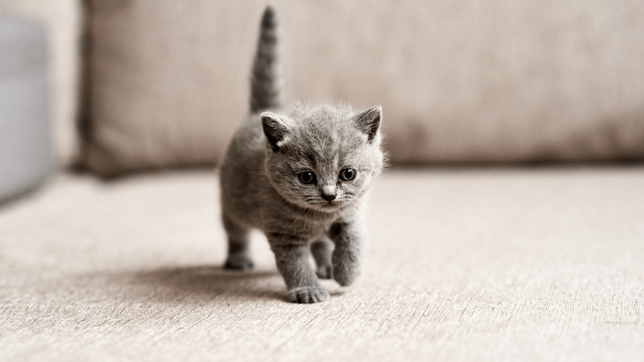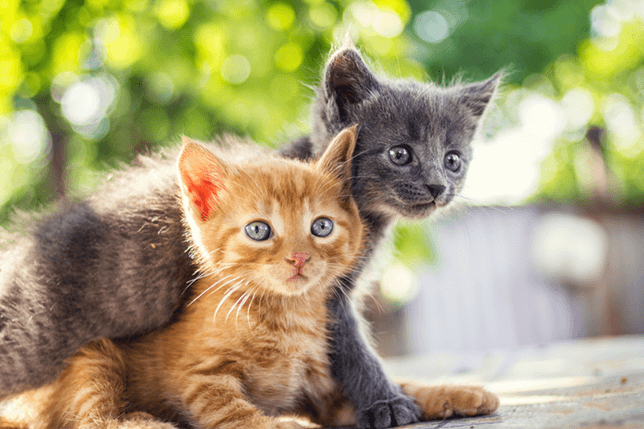15th March 2022
Kitten timeline – First year
Your little tigers first weeks are very important, it’s when new sights, sounds and foods will be tasted and skills will be learned. To make these tender years a little easier we’ve put together a little timeline.
Weeks 1-4: Senses development
Your little tiger comes into your world deaf and blind. During the first week they will slowly open their eyes so try to keep them away from bright lights.
Within the second week those cute little kitten gnashers start to come in.
Later, usually around weeks three and four, their eyes will change from the bright blue to the colour that will be staring (out of love) at you for the rest of their life.
Shortly after their ears will begin to twist and flick towards all the new sounds of their world. Try keep it down, though, as your little tiger adjusts to the noise around them.
Around this time, you’ll be able to witness your little tiger take their very first wobbly steps, very cute. But, watch out… they’ll become a trip hazard in no time as they gain their balance.

Weeks 5-9: Exploration and vaccinations
These weeks are the tentative ones where you wish you could wrap them up and cuddle them forever. Fight the urge!
It’s very important to socialise your little tiger early, you can do this by introducing them to new people, other pets or just letting them roam around the house (under close supervision of course) to get them used to all those new sights, smells and sounds.
During these weeks is the prime time for a vet visit, usually 6-8 weeks, for their vaccinations. Their first vaccination should include vaccines for rabies, respiratory infections and distemper. The vets will most likely provide you further information of when to book the next round (oh yeah, there are more) of vaccinations.
Weeks 10-14: Weaning, neutering, hunting and communication
This is when you can start introducing your little tiger to new food types and wean them off mummy.
Young kittens need to eat a lot more than an adult cat. Their stomachs are still growing so feed them morning, afternoon and evening with a mix of biscuits and wet food.
The wet food will help them remain hydrated which can only benefit your little tiger in their later years. Be careful, though, your little tiger is great at fooling you into feeding them again… Cats need to watch their waistlines as obesity is becoming more common.
During this period, it is also recommended, if you are considering it, getting your little tiger neutered.
This is also the time for them to learn that all important feline instinct, hunting. Your little tiger can learn from watching their mother or another family cat. Alternatively, being as playful with them as possible will help them too, most little tigers love string.
They will also learn how to banter with other cats, that’s right, cats banter. They will learn how to communicate with others and when to play and run and hide for another day.

6 months: Weight gain
If you decide to have your little tiger neutered, they could be prone to gaining a little weight… as stated previously a meal routine of morning, afternoon and evening meals will help you monitor how much their eating and watch their weight. A vet will be able to offer more advice around obesity if necessary.
6 months to 12: Adolescence, immune system and musculoskeletal growth
During this period your little tiger is an adolescent and is a very key time in the growth of their immune system as they discover and encounter new things every day. Certain kitten food can help build your little tigers immune system, please consult your vet for any information on which might be best.
This is also where their bones and muscles continue to grow and shape them into the tiger they will become. They’ll probably be a stroppy little tiger during this time, but we find persistence is key in your little tiger’s routine as they will carry this through to their adult years and love you for it… in the long run.
BONUS:What’s with the zoomies? Excess energy, that’s all, your little tiger is perfectly sane. When young cats (older cats get the zoomies, too) have pent up energy they like to let loose by darting from room to room, and up and down your stairs. If you’re little tiger is a house cat this will be more frequent, outdoors cats not so much as they have a huge concrete jungle to play in.
Looking for more cat advice?
We’ve written some handy cat advice guides, to help you unlock the secrets of your mysterious moggy.
Need kitten insurance?
Cat insurance can help cover the cost of veterinary treatment if your kitten gets injured or falls ill.
We know pets
Our pets are part of the family. To achieve our vision of a better future for pets everywhere, we work with our partners, vets, and other veterinary professionals who are pioneering the latest advancements in animal care. Our campaigns, articles, and events are crafted to support, educate, and celebrate pet owners, while our policies are designed to provide peace of mind at an affordable price.
Yet our policies don’t just protect against the unexpected – they have purpose, too.
Since we were founded over 25 years ago, we've provided industry-leading policies that protect the nation’s pets, while also making a difference to animal welfare and our planet. Thanks to you, our policyholders, we've donated over £9 million to more than 830 animal welfare charities and conservancies, helping to support vulnerable pets and wildlife around the world.
We’re proud to be wildly different. Are you?
